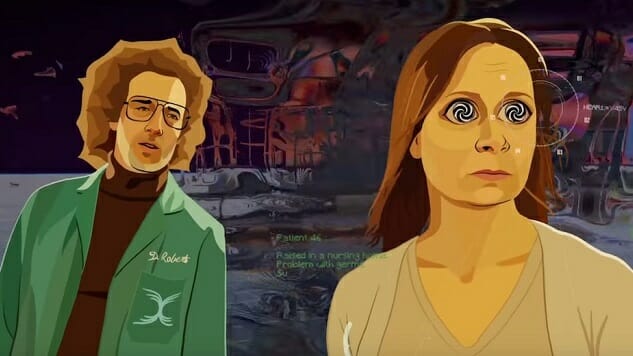Making Sense of Adult Swim’s Dream Corp LLC
Set photos taken by Brock Wilbur
I get it. You might be burned out on Adult Swim shows. I was there too. Maybe it’s part of getting older or maybe it comes in fandom cycles, but there are points when all its original programming starts to blend into an evening of Can You Believe How Random This Is? I get it. And that’s why it took me a while to finally get to Dream Corp LLC, a show where terrible scientists use bad science to take a look inside people’s dreams and do weird, random things. No one ever sold me on expecting more from the show, and the only off-channel marketing I encountered were the bus stop ads that people in LA thought were an unintentional disaster.
It would be a real tragedy to let this show fade into the background, because while the surface looks like standard late-night Adult Swim jokey weirdness, Dream Corp LLC hides some of the most visually exciting and bighearted episodes of television you could hope for.
Within the world of this laboratory, Dr. Roberts (Napoleon Dynamite’s Jon Gries) and his team (Ahmed Bharoocha, Mark Proksch, Stephanie Allynne) wind up offering a job to a patient who can’t pay (Good Neighbor’s Nicholas Rutherford) and together they dive into the brains of the staff and a rotating cast of patients which include the likes of Dave Coulier and Liam Neeson. The team is assisted by a robot named T.E.R.R.Y., voiced by co-producer Stephen Merchant, whose body is the product of Jim Henson’s puppet labs. Their madcap adventures into the mind all revolve around a dream world that is always shown in beautiful rotoscoped nightmares. If you think it looks a lot like A Scanner Darkly, that’s because they have a rotoscoper from that team running the animation. It’s a bizarre delight to see something so eerie and complicated on TV, but it really takes a creative force to make it as worthwhile as it comes across.
Creator/writer/editor Daniel Stessen developed the idea of a sleep study that blends into a hallucinogenic altered state after working with his rotoscoper on an indie circuit film called The Gold Sparrow a few years back. Since then, they’ve been working to bring their vision to television, by figuring out the economics of scale and digital tricks necessary to animate one episode of Dream Corp in a month—instead of over the course of years. It’s a perfect match of form to function and it allows Stessen to explore comedy in some wholly innovative ways.
According to Stessen, his process is a kind of mediation, where he allows ideas to flow and then revisits them later. This allows for a natural progression of dream logic in a show about dream logic.
“What draws me to dream studies and this technology / idea is that no one knows anything about it,” Stessen says. “That’s ridiculous. Everyone dreams but no one knows anything about it. Which makes it perfect for me, because I can make a procedural comedy out of something that does not exist. I can be an expert in nothing.”
Stessen has used that make believe expertise to probe complicated human problems. One of the best episodes of season one features two friends attempting to solve their issues and, within the first few minutes, they find themselves attacked by the Predator, who swiftly becomes a metaphor for friendship itself. It also prompted us to ask how a small Adult Swim show gets the rights to use the Predator as a friendship metaphor.
“That is not my job,” Stessen laughs. “I wrote it and someone made it work.”
And that sums up Dream Corp LLC pretty succinctly. Stessen has an idea and then the team makes it happen, and somehow it winds up on your TV.
-

-

-

-

-

-

-

-

-

-

-

-

-

-

-

-

-

-

-

-

-

-

-

-

-

-

-

-

-

-

-

-

-

-

-

-

-

-

-

-











































